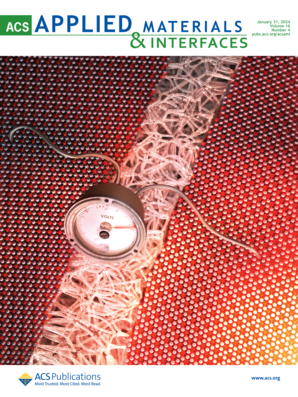An Olsalazine-Loaded Hollow Mesoporous Prussian Blue/Polydopamine Nanozyme Alleviates Anxiety/Depression-like Behavior and Enhances Brain Neural Activity in Colitis Mice.
IF 8.3
2区 材料科学
Q1 MATERIALS SCIENCE, MULTIDISCIPLINARY
引用次数: 0
Abstract
Individuals diagnosed with inflammatory bowel disease (IBD) exhibit a markedly elevated prevalence of psychiatric disorders, particularly anxiety and depression. However, the underlying mechanisms contributing to the development of these psychiatric conditions in IBD patients remain poorly understood, and no effective therapeutic strategy has been definitively established. Recent advancements in nanotechnology-based interventions offer promising potential for restoring gut homeostasis, which may mitigate inflammation and oxidative stress associated with IBD. Herein, we first synthesized hollow mesoporous Prussian blue (HMPB)/polydopamine (HMPB/PDA) nanoparticles (NPs), followed by physical loading with olsalazine (Olsa) (Olsa@HMPB/PDA NPs) to reshape intestinal homeostasis and relieve accompanying anxiety/depression-like behavior in colitis mice. The Olsa@HMPB/PDA NPs displayed a macroporous structure with high biocompatibility and reactive oxygen species scavenging activity and released the drug gradually in the inflammatory environment. It could enhance intestinal retention after oral gavage administration following IBD in mice. Mechanistically, the composite demonstrated efficacy in significantly reducing pro-inflammatory cytokine levels, regulated the polarization of macrophages, and attenuated mitochondrial dysfunction via its dual anti-inflammatory and antioxidant properties, ultimately leading to substantial mitigation of colitis symptoms in IBD mice. Furthermore, we found that dextran sodium sulfate (DSS) induced microglia activation and decreased neuronal activation in the CA1 hippocampus of mice, associated with anxiety/depression-like behavior. As the observed modulation of the dysfunction of neuroinflammation and neuronal activation of CA1 hippocampus, Olsa@HMPB/PDA NPs treatment alleviated anxiety/depression-like behavior in DSS mice. Overall, this nanozyme established a paradigm in combined IBD therapy with psychological comorbidities.奥萨拉嗪负载的中空介孔普鲁士蓝/多多巴胺纳米酶减轻结肠炎小鼠的焦虑/抑郁样行为并增强大脑神经活动
诊断为炎症性肠病(IBD)的个体表现出明显升高的精神疾病患病率,特别是焦虑和抑郁。然而,促成IBD患者这些精神疾病发展的潜在机制仍然知之甚少,并且没有明确建立有效的治疗策略。基于纳米技术的干预措施的最新进展为恢复肠道稳态提供了有希望的潜力,这可能减轻与IBD相关的炎症和氧化应激。在此,我们首先合成中空介孔普鲁士蓝(HMPB)/聚多巴胺(HMPB/PDA)纳米颗粒(NPs),然后用奥萨拉嗪(Olsa) (Olsa@HMPB/PDA NPs)进行物理负荷,以重塑肠道稳态并缓解结肠炎小鼠伴随的焦虑/抑郁样行为。Olsa@HMPB/PDA NPs具有高生物相容性和清除活性氧活性的大孔结构,并在炎症环境中逐渐释放药物。它能增强小鼠IBD后灌胃后的肠道保留。在机制上,该复合物通过其双重抗炎和抗氧化特性显着降低促炎细胞因子水平,调节巨噬细胞极化,减轻线粒体功能障碍,最终导致IBD小鼠结肠炎症状的显著缓解。此外,我们发现右旋糖酐硫酸钠(DSS)诱导小鼠CA1海马区小胶质细胞激活并降低神经元激活,这与焦虑/抑郁样行为有关。通过观察到的神经炎症功能障碍和CA1海马神经元激活的调节,Olsa@HMPB/PDA NPs治疗减轻了DSS小鼠的焦虑/抑郁样行为。总的来说,这种纳米酶在IBD与心理合并症的联合治疗中建立了一个范例。
本文章由计算机程序翻译,如有差异,请以英文原文为准。
求助全文
约1分钟内获得全文
求助全文
来源期刊

ACS Applied Materials & Interfaces
工程技术-材料科学:综合
CiteScore
16.00
自引率
6.30%
发文量
4978
审稿时长
1.8 months
期刊介绍:
ACS Applied Materials & Interfaces is a leading interdisciplinary journal that brings together chemists, engineers, physicists, and biologists to explore the development and utilization of newly-discovered materials and interfacial processes for specific applications. Our journal has experienced remarkable growth since its establishment in 2009, both in terms of the number of articles published and the impact of the research showcased. We are proud to foster a truly global community, with the majority of published articles originating from outside the United States, reflecting the rapid growth of applied research worldwide.
 求助内容:
求助内容: 应助结果提醒方式:
应助结果提醒方式:


